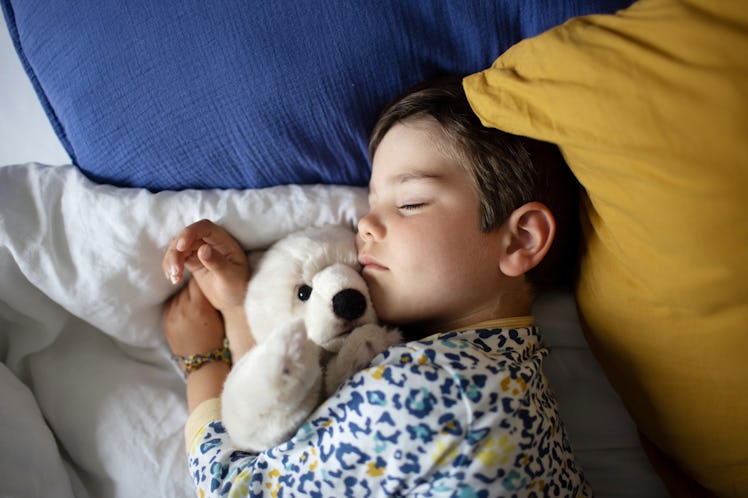When Can A Baby Sleep With A Stuffed Animal? A Sleep Specialist Explains
As a part of a bedtime ritual, a mellow, imaginative toy can help lead a kid to slumber.

A baby’s stuffed animal is their best friend, but it’s also a suffocation risk. That’s why the American Academy of Pediatrics (AAP) recommends keeping stuffed animals, blankets, and other soft objects away from where a baby sleeps until they are 12 months old — these objects can lead to sudden infants death syndrome (SIDS), suffocation, and strangulation.
But many experts find this recommendation to be too cautious. So when can babies use blankets, and when can a baby sleep with stuffed animals?
When Can Babies Use Blankets?
Per the AAP, you should wait until a child is at least 1-year-old before you let them sleep with a blanket. Some pediatricians give the okay at 6 months of age. However, blankets pose the greatest risk to babies between the ages of 5 and 11 months because they have the motor skills to wiggle and move around in their crib, but not necessarily enough to untangle themselves if the blanket were suffocating them.
Fortunately, your baby doesn’t need a blanket. If you dress them in one more layer of clothing than you would feel comfortable wearing in their room, your kid should be set. In fact, a blanket can actually cause a baby to overheat, further increasing their risk of SIDS. If you’re worried that your baby is too chilly, footie pajamas are a safer alternative to a blanket.
When you do give your child a blanket, opt for a fabric that’s easier to breathe through rather than something heavy like a quilt. Avoid blankets with dangly bits such as loose strings or ribbons.
When Can a Baby Sleep With a Stuffed Animal?
Stuffed animals have no business being in a crib at all during the first few months of a child’s life. That’s because the risk of SIDS for babies increases when crib toys or stuffed animals are present in a baby’s sleeping area.
However, around 3 months of age, the rate of SIDS deaths nosedives, and stuffed animals can tentatively join the slumber party. (Keep in mind though that the AAP still recommends holding off until the baby is a year old.)
There’s a good reason for stuffed animals to get an invitation. These “transitional objects” help kids soothe themselves back to sleep.
“Typically our recommendation is some kind of plush toy or a blanket,” says pediatric psychologist and sleep specialist Daniel Lewin, Ph.D. “Essentially, a toy that a child could engage in pretend-play with rather than a toy that is intrinsically more exciting, like a Hot Wheels car.”
That said, Lewin notes that sometimes kids prefer non-fluffy items. “We will sometimes see kids who are more obsessed with LEGO pieces or something not as cuddly,” he notes. “Having that in bed with them so they can manipulate it is fine.” But don’t let children sleep with any toys that are small enough to pose a choking hazard.
Parents shouldn’t worry too much about keeping a kid from taking stuffed animals or toys to bed, as long as the toys promote calm, imaginative play. Lewin stresses that there’s nothing wrong with post-lights-out activity as long as the play is about winding down to sleep rather than winding up. “Research has shown they’re up doing things before sleeping and even during the night — more than parents expect,” he says.
There are some additional rules about the toys carted to bed, however. It’s helpful for the toy to not be part of the regular daytime toy population, regardless of what it is. And if a toy is too loud or active for a bedtime snuggle, then you can use it as part of a bedtime ritual. The child can bring it to bed, then hand it over to their parents when they leave the room.
If you allow your child to pick a toy to bring to bed, then that choice should happen in a standardized way, along with teeth brushing and story time, to move the kid to bed and the adult out of the room.
This article was originally published on